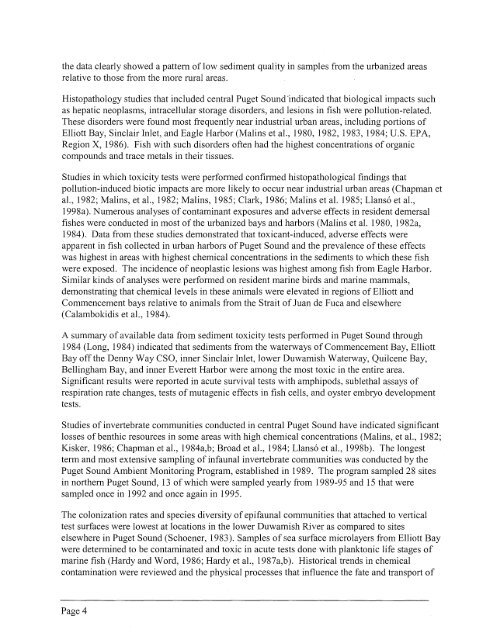Sediment Quality in Puget Sound Year 2 - Center for Coastal ...
Sediment Quality in Puget Sound Year 2 - Center for Coastal ...
Sediment Quality in Puget Sound Year 2 - Center for Coastal ...
Create successful ePaper yourself
Turn your PDF publications into a flip-book with our unique Google optimized e-Paper software.
the data clearly showed a pattern of low sediment quality <strong>in</strong> samples from the urbanized areas<br />
relative to those from the more rural areas.<br />
Histopathology studies that <strong>in</strong>cluded central <strong>Puget</strong> <strong>Sound</strong> "<strong>in</strong>dicated that biological impacts such<br />
as hepatic neoplasms, <strong>in</strong>tracellular storage disorders, and lesions <strong>in</strong> fish were pollution-related.<br />
These disorders were found most frequently near <strong>in</strong>dustrial urban areas, <strong>in</strong>clud<strong>in</strong>g portions of<br />
Elliott Bay, S<strong>in</strong>clair Inlet, and Eagle Harbor (Mal<strong>in</strong>s et al., 1980, 1982, 1983, 1984; U.S. EPA,<br />
Region X, 1986). Fish with such disorders often had the highest concentrations of organic<br />
compounds and trace metals <strong>in</strong> their tissues.<br />
Studies <strong>in</strong> which toxicity tests were per<strong>for</strong>med confirmed histopathological f<strong>in</strong>d<strong>in</strong>gs that<br />
pollution-<strong>in</strong>duced biotic impacts are more likely to occur near <strong>in</strong>dustrial urban areas (Chapman et<br />
al., 1982; Mal<strong>in</strong>s, et al., 1982; Mal<strong>in</strong>s, 1985; Clark, 1986; Mal<strong>in</strong>s et al. 1985; Llanso et al.,<br />
1998a). Numerous analyses of contam<strong>in</strong>ant exposures and adverse effects <strong>in</strong> resident demersal<br />
fishes were conducted <strong>in</strong> most of the urbanized bays and harbors (Mal<strong>in</strong>s et al. 1980, 1982a,<br />
1984). Data from these studies demonstrated that toxicant-<strong>in</strong>duced, adverse effects were<br />
apparent <strong>in</strong> fish collected <strong>in</strong> urban harbors of <strong>Puget</strong> <strong>Sound</strong> and the prevalence of these effects<br />
was highest <strong>in</strong> areas with highest chemical concentrations <strong>in</strong> the sediments to which these fish<br />
were exposed. The <strong>in</strong>cidence of neoplastic lesions was highest among fish from Eagle Harbor.<br />
Similar k<strong>in</strong>ds of analyses were per<strong>for</strong>med on resident mar<strong>in</strong>e birds and mar<strong>in</strong>e mammals,<br />
demonstrat<strong>in</strong>g that chemical levels <strong>in</strong> these animals were elevated <strong>in</strong> regions of Elliott and<br />
Commencement bays relative to animals from the Strait of Juan de Fuca and elsewhere<br />
(Calambokidis et al., 1984).<br />
A summary of available data from sediment toxicity tests per<strong>for</strong>med <strong>in</strong> <strong>Puget</strong> <strong>Sound</strong> through<br />
1984 (Long, 1984) <strong>in</strong>dicated that sediments from the waterways of Commencement Bay, Elliott<br />
Bay off the Denny Way CSO, <strong>in</strong>ner S<strong>in</strong>clair Inlet, lower Duwamish Waterway, Quilcene Bay,<br />
Bell<strong>in</strong>gham Bay, and <strong>in</strong>ner Everett Harbor were among the most toxic <strong>in</strong> the entire area.<br />
Significant results were reported <strong>in</strong> acute survival tests with amphipods, sublethal assays of<br />
respiration rate changes, tests of mutagenic effects <strong>in</strong> fish cells, and oyster embryo development<br />
tests.<br />
Studies of <strong>in</strong>vertebrate communities conducted <strong>in</strong> central <strong>Puget</strong> <strong>Sound</strong> have <strong>in</strong>dicated significant<br />
losses of benthic resources <strong>in</strong> some areas with high chemical concentrations (Mal<strong>in</strong>s, et al., 1982;<br />
Kisker, 1986; Chapman et al., 1984a,b; Broad et al., 1984; Llanso et al., 1998b). The longest<br />
term and most extensive sampl<strong>in</strong>g of <strong>in</strong>faunal <strong>in</strong>vertebrate communities was conducted by the<br />
<strong>Puget</strong> <strong>Sound</strong> Ambient Monitor<strong>in</strong>g Program, established <strong>in</strong> 1989. The program sampled 28 sites<br />
<strong>in</strong> northern <strong>Puget</strong> <strong>Sound</strong>, 13 of which were sampled yearly from 1989-95 and 15 that were<br />
sampled once <strong>in</strong> 1992 and once aga<strong>in</strong> <strong>in</strong> 1995.<br />
The colonization rates and species diversity of epifaunal communities that attached to vertical<br />
test surfaces were lowest at locations <strong>in</strong> the lower Duwamish River as compared to sites<br />
elsewhere <strong>in</strong> <strong>Puget</strong> <strong>Sound</strong> (Schoener, 1983). Samples of sea surface microlayers from Elliott Bay<br />
were determ<strong>in</strong>ed to be contam<strong>in</strong>ated and toxic <strong>in</strong> acute tests done with planktonic life stages of<br />
mar<strong>in</strong>e fish (Hardy and Word, 1986; Hardy et al., 1987a,b). Historical trends <strong>in</strong> chemical<br />
contam<strong>in</strong>ation were reviewed and the physical processes that <strong>in</strong>fluence the fate and transport of<br />
Page 4







